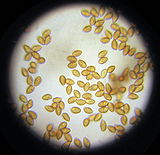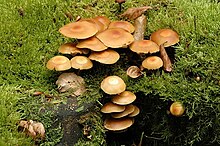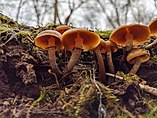Galerina marginata
| Galerina marginata | |
|---|---|

| |
| Scientific classification | |
| Domain: | Eukaryota |
| Kingdom: | Fungi |
| Division: | Basidiomycota |
| Class: | Agaricomycetes |
| Order: | Agaricales |
| Family: | Hymenogastraceae |
| Genus: | Galerina |
| Species: | G. marginata
|
| Binomial name | |
| Galerina marginata (
Batsch) Kühner (1935) | |
| Synonyms | |
|
Agaricus marginatus Batsch (1789) | |
| Galerina marginata saprotrophic | |
|---|---|
| Edibility is deadly | |
Galerina marginata, known colloquially as funeral bell, deadly skullcap, autumn skullcap or deadly galerina, is a
G. marginata is widespread in the
Before 2001, the species G. autumnalis, G. oregonensis, G. unicolor, and G. venenata were thought to be distinct from G. marginata due to differences in habitat and the
Taxonomy and naming
What is now recognized as a single
Another species analysed in Gulden's 2001 study, Galerina pseudomycenopsis, also could not be distinguished from G. marginata based on ribosomal DNA sequences and restriction fragment length polymorphism analyses. Because of differences in ecology, fruit body color and spore size combined with inadequate sampling, the authors preferred to maintain G. pseudomycenopsis as a distinct species.[1] A 2005 study again failed to separate the two species using molecular methods, but reported that the incompatibility demonstrated in mating experiments suggests that the species are distinct.[7]
In the fourth edition (1986) of Singer's comprehensive
The
Description


The
Based on the collective descriptions of the five taxa now considered to be G. marginata, the texture of the surface shows significant variation. Smith and Singer give the following descriptions of surface texture: from "viscid" (G. autumnalis),[4] to "shining and viscid to lubricous when moist" (G. oregonensis),[18] to "shining, lubricous to subviscid (particles of dirt adhere to surface) or merely moist, with a fatty appearance although not distinctly viscid",[19] to "moist but not viscid" (G. marginata).[20] The cap surface remains smooth and changes colors with humidity (hygrophanous), pale to dark ochraceous tawny over the disc and yellow-ochraceous on the margin (at least when young), but fading to dull tan or darker when dry. When moist, the cap is somewhat transparent so that the outlines of the gills may be seen as striations. The flesh is pale brownish ochraceous to nearly white, thin and pliant, with an odor and taste varying from very slightly to strongly like flour (farinaceous).[20]
The gills are typically narrow and crowded together, with a broadly adnate to nearly decurrent attachment to the stem and convex edges. They are a pallid brown when young, becoming tawny at maturity. Some short gills, called lamellulae, do not extend entirely from the cap edge to the stem, and are intercalated among the longer gills. The stem ranges from 2 to 8 cm (3⁄4 to 3+1⁄8 in) long,[17] 3–9 mm thick at the apex, and stays equal in width throughout or is slightly enlarged downward. Initially solid, it becomes hollow from the bottom up as it matures. The membranous ring is located on the upper half of the stem near the cap, but may be sloughed off and missing in older specimens. Its color is initially whitish or light brown, but usually appears a darker rusty-brown in mature specimens that have dropped spores on it. Above the level of the ring, the stem surface has a very fine whitish powder and is paler than the cap; below the ring it is brown down to the reddish-brown to bistre base. The lower portion of the stem has a thin coating of pallid fibrils which eventually disappear and do not leave any scales. The spore print is rusty-brown.[20]
Microscopic characteristics

The spores measure 8–10 by 5–6 μm, and are slightly inequilateral in profile view, and egg-shaped in face view. Like all Galerina species, the spores have a plage, which has been described as resembling "a slightly wrinkled plastic shrink-wrap covering over the distal end of the spore".[21] The spore surface is warty and full of wrinkles, with a smooth depression where the spore was once attached via the sterigmatum to the basidium (the spore-bearing cell). When in potassium hydroxide (KOH) solution, the spores appear tawny or darker rusty-brown, with an apical callus. The basidia are four-spored (rarely with a very few two-spored ones), roughly cylindrical when producing spores, but with a slightly tapered base, and measure 21–29 by 5–8.4 μm.[20]
Similar species

The deadly Galerina marginata may be mistaken for a few
Another potential edible lookalike is the "velvet shank",
Habitat and distribution

Galerina marginata is a saprobic fungus,[6] obtaining nutrients by breaking down organic matter. It is known to have most of the major classes of secreted enzymes that dissolve plant cell wall polysaccharides, and has been used as a model saprobe in recent studies of ectomycorrhizal fungi.[27][28] Because of its variety of enzymes capable of breaking down wood and other lignocellulosic materials, the Department of Energy Joint Genome Institute (JGI) is currently sequencing its genome. The fungus is typically reported to grow on or near the wood of conifers, although it has been observed to grow on hardwoods as well.[22][1] Fruit bodies may grow solitarily, but more typically in groups or small clusters, and appear in the summer to autumn. Sometimes, they may grow on buried wood and thus appear to be growing on soil.[16]
Galerina marginata is widely distributed throughout the Northern Hemisphere, found in North America, Europe, Japan, Iran,
Toxicity
The toxins found in Galerina marginata are known as
Galerina marginata was shown in various studies to contain the amatoxins
The toxicity of certain Galerina species has been known for a century. In 1912, Charles Horton Peck reported a human poisoning case due to G. autumnalis.[46] In 1954, a poisoning was caused by G. venenata.[47] Between 1978 and 1995, ten cases caused by amatoxin-containing Galerinas were reported in the literature. Three European cases, two from Finland[48] and one from France[49] were attributed to G. marginata and G. unicolor, respectively. Seven North American exposures included two fatalities from Washington due to G. venenata,[16] with five cases reacting positively to treatment; four poisonings were caused by G. autumnalis from Michigan and Kansas,[50][51] in addition to poisoning caused by an unidentified Galerina species from Ohio.[52] Several poisonings have been attributed to collectors consuming the mushrooms after mistaking them for the hallucinogenic Psilocybe stuntzii.[53][54]
See also
- List of deadly fungi
Footnotes
- ^ .
- ^ Batsch AJGK (1789). Elenchus fungorum. Continuatio secunda [Record of Fungi] (PDF) (in Latin and German) (Second ed.). Halle. p. 65.[permanent dead link]
- ^ Vahl M. (1792). Flora Danica. Vol. 6. p. 7.
- ^ a b Smith and Singer, 1964, pp. 246–50.
- JSTOR 4547771.
- ^ a b Kuo M (August 2004). "Galerina marginata ("Galerina autumnalis")". MushroomExpert.Com. Retrieved 2010-03-01.
- S2CID 25887159.
- ^ Kühner R. (1935). "Le Genre Galera (Fr.) Quélet" [The Genus Galera (Fr.) Quélet]. Encyclopédie Mycologique (in French). 7: 1–240.
- ^ Smith and Singer, 1964, p. 235.
- ISBN 3-87429-254-1.
- ISBN 0-87565-309-X.
- ^ Evenson, 1997, p. 124. Retrieved 2010-03-04.
- ^ ISBN 0-7234-1576-5.
- ISBN 1-84537-474-6.
- ^ ISBN 0-919433-47-2.
- ^ ISBN 0-295-96480-4.
- ^ OCLC 797915861.
- ^ Smith and Singer, 1964, pp. 250–1.
- ^ Smith and Singer, 1964, pp. 256–9.
- ^ a b c d e f Smith and Singer, 1964, pp. 259–62.
- ^ Volk T. (2003). "Galerina autumnalis, the deadly Galerina". Tom Volk's Fungus of the Month. Department of Biology, University of Wisconsin-La Crosse. Retrieved 2010-03-01.
- ^ PMID 21148893.
- ISBN 0-472-85599-9.
- ISBN 0-520-03656-5.
- ISBN 0-7006-0571-1.
- ^ Evenson, 1997, pp. 25–26. Retrieved 2010-03-03.
- S2CID 969884.
- S2CID 5806797.
- ISBN 978-964-2725-29-8.
- .
- ISBN 4-635-09020-5.
- ISBN 0-88880-355-9.
- ^ Noordeloos ME, Gulden G (1992). "Studies in the genus Galerina from the Shefferville area on the Quebec-Labrador peninsula, Canada". Persoonia. 14 (4): 625–39.
- ^ Vargas O. (1993). "Observations on some little known macrofungi from Jalisco (Mexico)". Mycotaxon. 49: 437–47.
- PMID 17360169.
- ^ Russell AB. "Galerina autumnalis". Poisonous Plants of North Carolina. Department of Horticultural Science, North Carolina State University. Retrieved 2010-02-19.
- JSTOR 3756526.
- ^ Tyler VE, Malone MH, Brady LR, Khanna JM, Benedict RG (1963). "Chromatographic and pharmacologic evaluation of some toxic Galerina species". Lloydia. 26 (3): 154–7.
- PMID 5929764.
- ^ Benedict RG, Brady LR (1967). "Further studies on fermentative production of toxic cyclopeptides by Galerina Marginata (Fr. Kühn)". Lloydia. 30: 372–8.
- PMID 796725.
- ^ Andary C, Privat G, Enjalbert F, Mandrou B (1979). "Teneur comparative en amanitines de différentes Agaricales toxiques d'Europe" [Comparative content in amanitins of different European toxic Agaricales]. Documents Mycologiques (in French). 10 (37–38): 61–8.
- ^ Besl H, Mack P, Schmid-Heckel H (1984). "Giftpilze in den Gattungen Galerina und Lepiota" [Poisonous mushrooms in the genera Galerina and Lepiota]. Zeitschrift für Mykologie (in German). 50: 183–93.
- ISBN 0-7627-3109-5.
- ISBN 0-387-16641-6.
- ^ Peck CH (1912). "Report of the State Botanist 1911". New York State Museum Bulletin. 157: 1–139. Archived from the original on 2010-03-11. Mention of poisoning by Pholiota autumnalis is on p. 9.
- PMID 13125209.
- PMID 688942.
- .
- ^ Trestrail JH (1991). "Mushroom poisoning case registry. North American Mycological Association Report 1989–1990". McIlvainea. 10 (1): 36–44.
- ^ Trestrail JH (1994). "Mushroom poisoning case registry. North American Mycological Association Report 1993". McIlvainea. 11 (2): 87–95.
- ^ Trestrail JH (1992). "Mushroom poisoning case registry. North American Mycological Association Report 1991". McIlvainea. 10 (2): 51–9.
- ^ Wood M, Stevens F. "Galerina autumnalis". California Fungi. MykoWeb. Retrieved 2010-03-01.
- ISBN 0-89815-839-7.
Cited books
- Evenson VS (1997). Mushrooms of Colorado and the Southern Rocky Mountains. Westcliffe Publishers. pp. 25–6. ISBN 978-1-56579-192-3.
- Smith AH, Singer R (1964). A Monograph of the Genus Galerina. New York, New York: Hafner Publishing Co.
External links
 Media related to Galerina marginata at Wikimedia Commons
Media related to Galerina marginata at Wikimedia Commons


